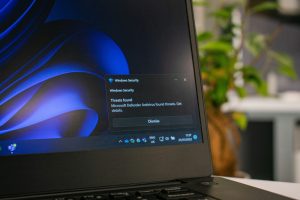Windows Defender Exploit & Defense Strategies

1. Headline Spotlight: Akira Ransomware Exploits Windows Defender via Intel Driver
Security researchers at GuidePoint Security have uncovered a sophisticated attack chain involving the Akira ransomware. Attackers exploit a legitimate Intel CPU tuning driver—rwdrv.sys (used by ThrottleStop)—to load a secondary malicious driver, hlpdrv.sys. This malicious driver then modifies the system registry to disable Microsoft Defender's anti-spyware protections.(Office of Information Security, TechRadar)
This represents a BYOVD (Bring Your Own Vulnerable Driver) attack, where threat actors leverage signed, trusted drivers to subvert built-in security defenses.(Tom's Guide)
Action Needed:
- Implement and monitor YARA detection rules and IoCs published by GuidePoint.
- Proactively watch for Akira-related indicators and restrict the use of untrusted or old drivers.
- Encourage users to download software only from verified sources.
2. Emerging Threat: AI-Powered Malware Bypassing Defender
In a proof-of-concept study, researchers at Outflank trained an open-source LLM (Qwen 2.5) to generate malware capable of evading Microsoft Defender approximately 8% of the time—far better than competing models. While not yet a widespread threat, this showcases cybersecurity’s increasing AI arms race.(Tom's Guide, Office of Information Security, Tom's Hardware)
Defensive Actions:
- Stay informed on AI-threat developments and adapt detection systems accordingly.
- Prioritize existing threat vectors—like phishing and social-engineering—that remain more prevalent risks.
3. Reminder: Windows Defender SmartScreen Bypass (PoC Released)
A zero-day vulnerability in Windows Defender SmartScreen was patched in November. However, a proof-of-concept (PoC) exploit has since emerged, enabling attackers to bypass safety warnings entirely—potentially exposing users to phishing or malicious sites.(Fortified Health Security)
Mitigation Steps:
- Ensure all systems are fully patched with the latest Windows updates.
- Continue educating users to recognize phishing tactics—even when SmartScreen appears to fail.
4. Quick Facts & Tips: Windows Defender Exploit Protection
Windows Defender includes built-in Exploit Protection mechanisms—such as DEP, CFG, ASLR—that fortify both system-wide and app-level defenses. These can be configured via Windows Security settings, Group Policy, PowerShell, Intune, or Configuration Manager.(NinjaOne, Fortified Health Security)
Best Practices:
- Customize mitigation settings carefully: begin with audit mode on a limited number of devices before broad deployment.(Microsoft Learn)
- Export configurations as XML for consistent application across environments.(Microsoft Learn)
Newsletter Summary Table
| Threat / Feature | Key Takeaway | Recommended Action |
| Akira ransomware via BYOVD | Legitimate drivers abused to disable Defender | Monitor IoCs, block untrusted drivers |
| AI-generated malware (8% success) | Emerging proof-of-concept threat | Stay informed, enhance defenses |
| SmartScreen exploit (PoC released) | Users exposed to phishing and malicious links | Patch systems, train users |
| Exploit Protection tools | Built-in mitigations available in Defender | Use audit mode, export policies |
Your Next Steps Checklist
- Monitor systems for Akira-related indicators (YARA rules, IoCs).
- Restrict installation of unsigned or legacy drivers.
- Confirm full OS patch status—especially SmartScreen fix.
- Use audit-first deployment for exploit protection.
- Keep an eye on AI-based attack developments.
Final Thoughts
Microsoft Defender remains a capable defense, but as attackers grow more resourceful leveraging signed drivers and AI the importance of proactive configuration, patching, and user vigilance has never been greater.
